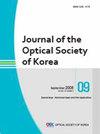Infrared-to-Visible Up-conversion in Er-Pr-Yb Triply Doped Oxyfluoride Glass Ceramics
Q Physics and Astronomy
引用次数: 1
Abstract
We synthesized Er3+-Yb3+, Pr3+-Yb3+, and Er3+-Pr3+-Yb3+-doped oxyfluoride glass ceramics containing CaF2 nanocrystals by proper thermal treatments. Spectral characteristics of down- and up-converted emissions in three kinds of glass ceramics under 365-nm and 980-nm excitations were compared and explained by cross relaxations, excited-state absorptions, and energy-transfer processes between different ions. The huge reduction of up-conversion emission in the triply doped glass ceramics under 980-nm excitation compared to the Er3+-Yb3+ codoped one was explained by the split pump power and the direct energy transfer from Er3+ to Pr3+ ions. Increasing Yb3+ concentration from 2% to 10% in the triply doped glass ceramics showed more than quadratic enhancement of the absorbed power, and we explained it by the enhanced energy-transfer efficiency from Yb3+ to Er3+ ions. We also observed enhanced up-converted emissions of Er3+ and Pr3+ ions in three kinds of glass ceramics under simultaneous excitation at 980 nm and 1550 nm, and suggested detailed up-conversion mechanisms.Er-Pr-Yb三掺氟氧玻璃陶瓷的红外-可见光上转换
通过适当的热处理,合成了Er3+-Yb3+、Pr3+-Yb3+和Er3+-Pr3+-Yb3+掺杂的含CaF2纳米晶氟氧玻璃陶瓷。通过交叉弛豫、激发态吸收和不同离子之间的能量转移过程,比较了三种玻璃陶瓷在365nm和980nm激发下的下转换和上转换发射光谱特性。在980 nm激发下,三掺杂玻璃陶瓷的上转换发射比Er3+-Yb3+共掺杂玻璃陶瓷的上转换发射明显降低,这可以解释为Er3+离子向Pr3+离子的直接能量转移和泵浦功率的分裂。当Yb3+浓度从2%增加到10%时,三掺杂玻璃陶瓷的吸收功率增加了2倍以上,这可以用Yb3+到Er3+离子的能量转移效率提高来解释。我们还观察到在980 nm和1550 nm同时激发下,三种玻璃陶瓷中Er3+和Pr3+离子的上转换发射增强,并提出了详细的上转换机制。
本文章由计算机程序翻译,如有差异,请以英文原文为准。
求助全文
约1分钟内获得全文
求助全文

 求助内容:
求助内容: 应助结果提醒方式:
应助结果提醒方式:


